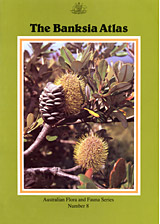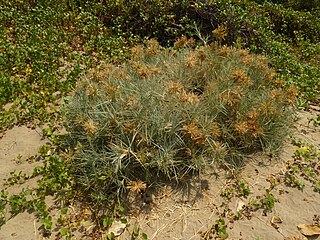Related Research Articles

The Banksia Atlas is an atlas that documents the ranges, habitats and growth forms of various species and other subgeneric taxa of Banksia, an iconic Australian wildflower genus. First published in 1988, it was the result of a three-year nationwide program involving over 400 amateur and professional volunteers.

Musgravea is a genus of rainforest tree from north-eastern Queensland.

Banksia nutans, commonly known as nodding banksia, is a species of shrub native to the south coast of Western Australia in the genus Banksia. Growing to a metre (3 ft) tall, it has pale blue-green fine-leaved foliage and unusual purple-brown inflorescences which hang upside down rather than grow upright like most other banksias.

Banksia plagiocarpa, commonly known as Dallachy's blue banksia, blue banksia or Hichinbrook banksia, is a species of shrub or tree in the plant genus Banksia. It occurs only on Hinchinbrook Island, Queensland and the immediately adjacent mainland. First collected in 1867, Banksia plagiocarpa was not described until 1981, when Alex George named it in his monograph of the genus Banksia. Genetic studies show it to be related to Banksia aquilonia, Banksia oblongifolia and Banksia robur.

Banksia repens, the creeping banksia, is a species of shrub in the plant genus Banksia. It occurs on the south coast of Western Australia from D'Entrecasteaux National Park in the west to Mount Ragged in the east.

Banksia sect. Oncostylis is one of four sections of subgenus Banksia subg. Banksia. It contains those Banksia species with hooked pistils. All of the species in Oncostylis also exhibit a top-down sequence of flower anthesis, except for Banksia nutans which is bottom-up.

Banksia ser. Spicigerae is a taxonomic series in the genus Banksia. It consists of the seven species in section Oncostylis that have cylindrical inflorescences. These range in form from small shrubs to tall trees. The leaves grow in either an alternate or whorled pattern, with various shape forms. The Spicigerae inflorescence is held erect, subtended by a whorl of branchlets, and retains a regular pattern until anthesis. The perianth limb is horizontal until anthesis, at which point the perianth opens from underneath. The pollen-presenter is ovoid or conical. The seed wings are not notched.

Flora of Australia is a 59 volume series describing the vascular plants, bryophytes and lichens present in Australia and its external territories. The series is published by the Australian Biological Resources Study who estimate that the series when complete will describe over 20 000 plant species. It was orchestrated by Alison McCusker.

Banksia sect. Banksia is one of four sections of Banksia subgenus Banksia. It contains those species of subgenus Banksia with straight or sometimes curved but not hooked styles. These species all have cylindrical inflorescences and usually exhibit a bottom-up sequence of flower anthesis. It is a widely distributed section, with taxa occurring in both the south west and east coastal distributions of the genus.

Banksia ser. Tetragonae is a taxonomic series in the genus Banksia. It consists of three closely related species of erect shrub with pendulous inflorescences in section Banksia. These are:

Banksia ser. Prostratae is a taxonomic series in the genus Banksia, a genus of iconic Australian wildflowers. It consists of six closely related species in section Banksia, all endemic to Western Australia, with a prostrate habit.

Banksia ser. Grandes is a taxonomic series in the genus Banksia. It consists of two closely related species in section Banksia, both endemic to Western Australia. These are B. grandis and B. solandri.

The Fungi of Australia form an enormous and phenomenally diverse group, a huge range of freshwater, marine and terrestrial habitats with many ecological roles, for example as saprobes, parasites and mutualistic symbionts of algae, animals and plants, and as agents of biodeterioration. Where plants produce, and animals consume, the fungi recycle, and as such they ensure the sustainability of ecosystems.

The flora of Australia comprises a vast assemblage of plant species estimated to over 21,000 vascular and 14,000 non-vascular plants, 250,000 species of fungi and over 3,000 lichens. The flora has strong affinities with the flora of Gondwana, and below the family level has a highly endemic angiosperm flora whose diversity was shaped by the effects of continental drift and climate change since the Cretaceous. Prominent features of the Australian flora are adaptations to aridity and fire which include scleromorphy and serotiny. These adaptations are common in species from the large and well-known families Proteaceae (Banksia), Myrtaceae, and Fabaceae.

Adenanthos detmoldii, commonly known as Scott River jugflower or yellow jugflower, is a species of shrub in the family Proteaceae. It is endemic to the south-west of Western Australia.

Adenanthos sect. Eurylaema is a taxonomic section of the flowering plant genus Adenanthos (Proteaceae). It comprises four species, all of which are endemic to southwest Western Australia.

Adenanthos sect. Adenanthos is a taxonomic section of the flowering plant genus Adenanthos (Proteaceae). It comprises 29 species. The centre of diversity is southwest Western Australia, with two species extending into South Australia and western Victoria.
Adenanthos labillardierei is a species of erect shrub endemic to the slopes of the Barren Ranges in the Fitzgerald River National Park in southwest Western Australia.
The Australian Faunal Directory (AFD) is an online catalogue of taxonomic and biological information on all animal species known to occur within Australia. It is a program of the Department of Climate Change, Energy, the Environment and Water of the Government of Australia. By May 12, 2021, the Australian Faunal Directory has collected information about 126,442 species and subspecies. It includes the data from the discontinued Zoological Catalogue of Australia and is regularly updated. Started in the 1980s, it set a goal to compile a "list of all Australian fauna including terrestrial vertebrates, ants and marine fauna" and create an "Australian biotaxonomic information system". This important electronic key and educative package enables faster and orderly identification of Australian centipede species.

Spinifex littoreus is a species of herb in the family Poaceae. The species is similar to Spinifex longifolius. It is native to tropical and subtropical areas of Asia and Australia.
References
- ↑ "Australian Biological Resources Study (ABRS) - DCCEEW". Australian Government - Department of Climate Change, Energy, the Environment and Water.
- 1 2 Australian Biological Resources Study (1979), Australian biological resources study, 1973-78, Australian Government Publishing Service, ISBN 978-0-642-90765-3
- ↑ Australian Biological Resources Study: Annual report, Australian Government Publishing Service, 1982, ISSN 0816-2840
- ↑ Flora of Australia, CSIRO Publishing, 1981, ISBN 978-0-643-06454-6